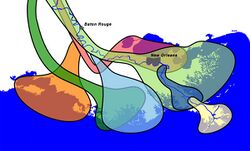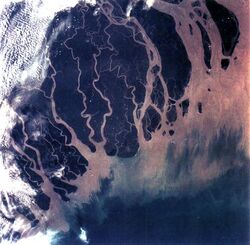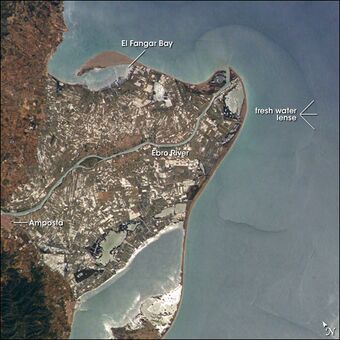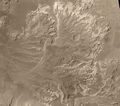Chemistry:River delta
A river delta is a landform created by deposition of sediment that is carried by a river as the flow leaves its mouth and enters slower-moving or stagnant water.[1][2] This occurs where a river enters an ocean, sea, estuary, lake, reservoir, or (more rarely) another river that cannot carry away the supplied sediment. The size and shape of a delta is controlled by the balance between watershed processes that supply sediment, and receiving basin processes that redistribute, sequester, and export that sediment.[3][4] The size, geometry, and location of the receiving basin also plays an important role in delta evolution. River deltas are important in human civilization, as they are major agricultural production centers and population centers. They can provide coastline defense and can impact drinking water supply.[5] They are also ecologically important, with different species' assemblages depending on their landscape position.
Formation

River deltas form when a river carrying sediment reaches either (1) a body of water, such as a lake, ocean, or reservoir, (2) another river that cannot remove the sediment quickly enough to stop delta formation, or (3) an inland region where the water spreads out and deposits sediments. The tidal currents also cannot be too strong, as sediment would wash out into the water body faster than the river deposits it. The river must carry enough sediment to layer into deltas over time. The river's velocity decreases rapidly, causing it to deposit the majority, if not all, of its load. This alluvium builds up to form the river delta.[7] When the flow enters the standing water, it is no longer confined to its channel and expands in width. This flow expansion results in a decrease in the flow velocity, which diminishes the ability of the flow to transport sediment. As a result, sediment drops out of the flow and deposits. Over time, this single channel builds a deltaic lobe (such as the bird's-foot of the Mississippi or Ural river deltas), pushing its mouth into the standing water. As the deltaic lobe advances, the gradient of the river channel becomes lower because the river channel is longer but has the same change in elevation (see slope).
As the slope of the river channel decreases, it becomes unstable for two reasons. First, gravity makes the water flow in the most direct course down slope. If the river breaches its natural levees (i.e., during a flood), it spills out into a new course with a shorter route to the ocean, thereby obtaining a more stable steeper slope.[8] Second, as its slope gets lower, the amount of shear stress on the bed decreases, which results in deposition of sediment within the channel and a rise in the channel bed relative to the floodplain. This makes it easier for the river to breach its levees and cut a new channel that enters the body of standing water at a steeper slope. Often when the channel does this, some of its flow remains in the abandoned channel. When these channel-switching events occur, a mature delta develops a distributary network.
Another way these distributary networks form is from deposition of mouth bars (mid-channel sand and/or gravel bars at the mouth of a river). When this mid-channel bar is deposited at the mouth of a river, the flow is routed around it. This results in additional deposition on the upstream end of the mouth-bar, which splits the river into two distributary channels. A good example of the result of this process is the Wax Lake Delta.
In both of these cases, depositional processes force redistribution of deposition from areas of high deposition to areas of low deposition. This results in the smoothing of the planform (or map-view) shape of the delta as the channels move across its surface and deposit sediment. Because the sediment is laid down in this fashion, the shape of these deltas approximates a fan. The more often the flow changes course, the shape develops as closer to an ideal fan, because more rapid changes in channel position results in more uniform deposition of sediment on the delta front. The Mississippi and Ural River deltas, with their bird's-feet, are examples of rivers that do not avulse often enough to form a symmetrical fan shape. Alluvial fan deltas, as seen by their name, avulse frequently and more closely approximate an ideal fan shape.
Most large river deltas discharge to intra-cratonic basins on the trailing edges of passive margins due to the majority of large rivers such as the Mississippi, Nile, Amazon, Ganges, Indus, and Yangtze discharging along passive continental margins.[9] This phenomenon is due to three big factors: topography, basin area, and basin elevation.[9] Topography along passive margins tend to be more gradual and widespread over a greater area enabling sediment to pile up and accumulate overtime to form large river deltas. Topography along active margins tend to be steeper and less widespread, which results in sediments not having the ability to pile up and accumulate due to the sediment traveling into a steep subduction trench rather than a shallow continental shelf.
There are many other smaller factors that could explain why the majority of river deltas form along passive margins rather than active margins. Along active margins, orogenic sequences cause tectonic activity to form over-steepened slopes, brecciated rocks, and volcanic activity resulting in delta formation to exist closer to the sediment source.[9][10] When sediment does not travel far from the source, sediments that build up are coarser grained and more loosely consolidated, therefore making delta formation more difficult. Tectonic activity on active margins causes the formation of river deltas to form closer to the sediment source which may affect channel avulsion, delta lobe switching, and auto cyclicity.[10] Active margin river deltas tend to be much smaller and less abundant but may transport similar amounts of sediment.[9] However, the sediment is never piled up in thick sequences due to the sediment traveling and depositing in deep subduction trenches.[9]
Types of deltas


Deltas are typically classified according to the main control on deposition, which is a combination of river, wave, and tidal processes,[11] depending on the strength of each.[12] The other two factors that play a major role are landscape position and the grain size distribution of the source sediment entering the delta from the river.[13]
Wave-dominated deltas
In wave dominated deltas, wave-driven sediment transport controls the shape of the delta, and much of the sediment emanating from the river mouth is deflected along the coast line.[11] The relationship between waves and river deltas is quite variable and largely influenced by the deepwater wave regimes of the receiving basin. With a high wave energy near shore and a steeper slope offshore, waves will make river deltas smoother. Waves can also be responsible for carrying sediments away from the river delta, causing the delta to retreat.[5] For deltas that form further upriver in an estuary, there are complex yet quantifiable linkages between winds, tides, river discharge, and delta water levels.[14][15]

Tide-dominated deltas
Erosion is also an important control in tide-dominated deltas, such as the Ganges Delta, which may be mainly submarine, with prominent sandbars and ridges. This tends to produce a "dendritic" structure.[16] Tidal deltas behave differently from a river- and wave-dominated deltas, which tend to have a few main distributaries. Once a wave- or river-dominated distributary silts up, it is abandoned, and a new channel forms elsewhere. In a tidal delta, new distributaries are formed during times when there is a lot of water around – such as floods or storm surges. These distributaries slowly silt up at a more or less constant rate until they fizzle out.[16]
Gilbert deltas
A Gilbert delta (named after Grove Karl Gilbert) is a type of delta formed from coarse sediments, as opposed to gently-sloping muddy deltas such as that of the Mississippi. For example, a mountain river depositing sediment into a freshwater lake would form this kind of delta.[17] [18] While some authors describe both lacustrine and marine locations of Gilbert deltas,[17] others note that their formation is more characteristic of the freshwater lakes, where it is easier for the river water to mix with the lakewater faster (as opposed to the case of a river falling into the sea or a salt lake, where less dense fresh water brought by the river stays on top longer).[19]
Gilbert himself first described this type of delta on Lake Bonneville in 1885.[19] Elsewhere, similar structures occur, for example, at the mouths of several creeks that flow into Okanagan Lake in British Columbia and forming prominent peninsulas at Naramata, Summerland, and Peachland.
Tidal freshwater deltas
A tidal freshwater delta[20] is a sedimentary deposit formed at the boundary between an upland stream and an estuary, in the region known as the "subestuary".[21] Drowned coastal river valleys that were inundated by rising sea levels during the late Pleistocene and subsequent Holocene tend to have dendritic estuaries with many feeder tributaries. Each tributary mimics this salinity gradient from their brackish junction with the mainstem estuary up to the fresh stream feeding the head of tidal propagation. As a result, the tributaries are considered to be "subestuaries". The origin and evolution of a tidal freshwater delta involves processes that are typical of all deltas[4] as well as processes that are unique to the tidal freshwater setting.[22][23] The combination of processes that create a tidal freshwater delta result in a distinct morphology and unique environmental characteristics. Many tidal freshwater deltas that exist today are directly caused by the onset of or changes in historical land use, especially deforestation, intensive agriculture, and urbanization.[24] These ideas are well illustrated by the many tidal freshwater deltas prograding into Chesapeake Bay along the east coastline of the United States. Research has demonstrated that the accumulating sediments in this estuary derive from post-European settlement deforestation, agriculture, and urban development.[25][26][27]
Estuaries
Other rivers, particularly those on coasts with significant tidal range, do not form a delta but enter into the sea in the form of an estuary. Notable examples include the Gulf of Saint Lawrence and the Tagus estuary.
Inland deltas

In rare cases the river delta is located inside a large valley and is called an inverted river delta. Sometimes a river divides into multiple branches in an inland area, only to rejoin and continue to the sea. Such an area is called an inland delta, and often occurs on former lake beds. The Inner Niger Delta and Peace–Athabasca Delta are notable examples. The Amazon also has an inland delta before the island of Marajó, and the Danube has one in the valley on the Slovak-Hungarian border between Bratislava and Iža.
In some cases, a river flowing into a flat arid area splits into channels that evaporate as it progresses into the desert. The Okavango Delta in Botswana is one example.
Mega deltas
The generic term mega delta can be used to describe very large Asian river deltas, such as the Yangtze, Pearl, Red, Mekong, Irrawaddy, Ganges-Brahmaputra, and Indus.
Sedimentary structure

The formation of a delta is complicated, multiple, and cross-cutting over time, but in a simple delta three main types of bedding may be distinguished: the bottomset beds, foreset/frontset beds, and topset beds. This three part structure may be seen in small scale by crossbedding.[17][28]
- The bottomset beds are created from the lightest suspended particles that settle farthest away from the active delta front, as the river flow diminishes into the standing body of water and loses energy. This suspended load is deposited by sediment gravity flow, creating a turbidite. These beds are laid down in horizontal layers and consist of the finest grain sizes.
- The foreset beds in turn are deposited in inclined layers over the bottomset beds as the active lobe advances. Foreset beds form the greater part of the bulk of a delta, (and also occur on the lee side of sand dunes).[29] The sediment particles within foreset beds consist of larger and more variable sizes, and constitute the bed load that the river moves downstream by rolling and bouncing along the channel bottom. When the bed load reaches the edge of the delta front, it rolls over the edge, and is deposited in steeply dipping layers over the top of the existing bottomset beds. Under water, the slope of the outermost edge of the delta is created at the angle of repose of these sediments. As the foresets accumulate and advance, subaqueous landslides occur and readjust overall slope stability. The foreset slope, thus created and maintained, extends the delta lobe outward. In cross section, foresets typically lie in angled, parallel bands, and indicate stages and seasonal variations during the creation of the delta.
- The topset beds of an advancing delta are deposited in turn over the previously laid foresets, truncating or covering them. Topsets are nearly horizontal layers of smaller-sized sediment deposited on the top of the delta and form an extension of the landward alluvial plain.[29] As the river channels meander laterally across the top of the delta, the river is lengthened and its gradient is reduced, causing the suspended load to settle out in nearly horizontal beds over the delta's top. Topset beds are subdivided into two regions: the upper delta plain and the lower delta plain. The upper delta plain is unaffected by the tide, while the boundary with the lower delta plain is defined by the upper limit of tidal influence.[30]
Examples of deltas

The Ganges-Brahmaputra Delta, which spans most of Bangladesh and West Bengal, India empties into the Bay of Bengal, is the world's largest delta.
The St. Clair River delta, between the Canadian province of Ontario and the U.S. state of Michigan, is the largest delta emptying into a body of fresh water.
Other deltas
- Amazon Delta
- Danube Delta
- Ebro Delta
- Fly Delta
- Ganges-Brahmaputra Delta
- Godavari Delta
- Irrawaddy Delta
- Indus River Delta
- Kaveri Delta
- Krishna
- Lena Delta
- Mackenzie Delta
- Mahanadi River Delta
- Mekong Delta
- Mississippi River Delta
- Niger Delta
- Nile Delta
- Okavango Delta
- Orinoco Delta
- Paraná Delta
- Parnaíba Delta
- Pearl River Delta
- Po Delta
- Red River Delta
- Rhine Delta
- Rhône Delta
- Sacramento–San Joaquin River Delta
- Salween River Delta
- Euphrates Delta
- Volga Delta
- Yangtze
- Yellow River (also known as Huanghe)
- Yukon–Kuskokwim Delta
- Zambezi Delta
Ecological threats to deltas
Human activities, such as the creation of dams for hydroelectric power or to create reservoirs can radically alter delta ecosystems. Dams block sedimentation, which can cause the delta to erode away. The use of water upstream can greatly increase salinity levels as less fresh water flows to meet the salty ocean water. While nearly all deltas have been impacted to some degree by humans, the Nile Delta and Colorado River Delta are some of the most extreme examples of the ecological devastation caused to deltas by damming and diversion of water. Construction, irrigation, and land alteration have impacted delta formation. As humans have altered surface roughness, runoff, and groundwater storage, studies have shown river delta retreat. However, historical data documents show that during the Roman Empire and Little Ice Age (times where there was considerable anthropogenic pressure), there were significant sediment accumulation in deltas. The industrial revolution has only amplified the impact of humans on delta growth and retreat.[31]
Deltas in the economy
Ancient deltas are a benefit to the economy due to their well sorted sand and gravel. Sand and gravel is often quarried from these old deltas and used in concrete for highways, buildings, sidewalks, and even landscaping. More than 1 billion tons of sand and gravel are produced in the United States alone.[32] Not all sand and gravel quarries are former deltas, but for ones that are, much of the sorting is already done by the power of water.
As lowlands often adjacent to urban areas, deltas often comprise extensive industrial and commercial areas as well as agricultural land. These uses are often in conflict. The Fraser Delta in British Columbia, Canada, includes the Vancouver Airport and the Roberts Bank Superport and the Annacis Island industrial zone, and a mix of commercial, residential and agricultural land. Space is so limited in the Lower Mainland region, and in British Columbia in general, which is very mountainous, that the Agricultural Land Reserve was created to preserve agricultural land for food production.
Deltas on Mars
Researchers have found a number of examples of deltas that formed in Martian lakes. Finding deltas is a major sign that Mars once had large amounts of water. Deltas have been found over a wide geographical range. Below are pictures of a few.[33]
-
Delta in Ismenius Lacus quadrangle, as seen by THEMIS.
-
Delta in Lunae Palus quadrangle, as seen by THEMIS.
-
Delta in Margaritifer Sinus quadrangle as seen by THEMIS.
-
Probable delta in Eberswalde crater, as seen by Mars Global Surveyor. Image in Margaritifer Sinus quadrangle.
See also
- Earth:Alluvial fan – Fan-shaped deposit of sediment
- Earth:Avulsion (river) – Rapid abandonment of a river channel and formation of a new channel
- Earth:Estuary – Partially enclosed coastal body of brackish water
References
- ↑ Miall, A. D. 1979. Deltas. in R. G. Walker (ed) Facies Models. Geological Association of Canada, Hamilton, Ontario.
- ↑ Elliot, T. 1986. Deltas. in H. G. Reading (ed.). Sedimentary environments and facies. Backwell Scientific Publications, Oxford.
- ↑ Blum, M.D.; Tornqvist, T.E. (2000). "Fluvial responses to climate and sea-level change: a review and look forward". Sedimentology 47: 2–48. doi:10.1046/j.1365-3091.2000.00008.x.
- ↑ 4.0 4.1 Pasternack, Gregory B.; Brush, Grace S.; Hilgartner, William B. (2001-04-01). "Impact of historic land-use change on sediment delivery to a Chesapeake Bay subestuarine delta" (in en). Earth Surface Processes and Landforms 26 (4): 409–427. doi:10.1002/esp.189. ISSN 1096-9837.
- ↑ 5.0 5.1 Anthony, Edward J. (2015-03-01). "Wave influence in the construction, shaping and destruction of river deltas: A review". Marine Geology 361: 53–78. doi:10.1016/j.margeo.2014.12.004.
- ↑ "How a Delta Forms Where River Meets Lake". 2014-08-12. https://www.jpl.nasa.gov/spaceimages/details.php?id=PIA19071.
- ↑ "Dr. Gregory B. Pasternack – Watershed Hydrology, Geomorphology, and Ecohydraulics :: TFD Modeling" (in en). http://pasternack.ucdavis.edu/research/projects/tidal-freshwater-deltas/tfd-modeling/.
- ↑ Slingerland, R. and N. D. Smith (1998), "Necessary conditions for a meandering-river avulsion," Geology (Boulder), 26, 435–438.
- ↑ 9.0 9.1 9.2 9.3 9.4 Milliman, J. D.; Syvitski, J. P. M. (1992). "Geomorphic/Tectonic Control of Sediment Discharge to the Ocean: The Importance of Small Mountainous Rivers". The Journal of Geology 100 (5): 525–544. doi:10.1086/629606.
- ↑ 10.0 10.1 Goodbred, S. L.; Kuehl, S. A. (2000). "The significance of large sediment supply, active tectonism, and eustasy on margin sequence development: Late Quaternary stratigraphy and evolution of the Ganges-Brahmaputra delta". Sedimentary Geology 133 (3–4): 227–248. doi:10.1016/S0037-0738(00)00041-5.
- ↑ 11.0 11.1 Galloway, W.E., 1975, Process framework for describing the morphologic and stratigraphic evolution of deltaic depositional systems, in Brousard, M.L., ed., Deltas, Models for Exploration: Houston Geological Society, Houston, Texas, pp. 87–98.
- ↑ Perillo, G. M. E. 1995. Geomorphology and Sedimentology of Estuaries. Elsevier Science B.V., New York.
- ↑ Orton, G.J.; Reading, H.G. (1993). "Variability of deltaic processes in terms of sediment supply, with particular emphasis on grain size". Sedimentology 40 (3): 475–512. doi:10.1111/j.1365-3091.1993.tb01347.x.
- ↑ "Dr. Gregory B. Pasternack – Watershed Hydrology, Geomorphology, and Ecohydraulics :: TFD Hydrometeorology" (in en). http://pasternack.ucdavis.edu/research/projects/tidal-freshwater-deltas/tfd-hydrometeorology/.
- ↑ Pasternack, Gregory B.; Hinnov, Linda A. (October 2003). "Hydrometeorological controls on water level in a vegetated Chesapeake Bay tidal freshwater delta". Estuarine, Coastal and Shelf Science 58 (2): 367–387. doi:10.1016/s0272-7714(03)00106-9.
- ↑ 16.0 16.1 Fagherazzi S., 2008, Self-organization of tidal deltas, Proceedings of the National Academy of Sciences, vol. 105 (48): 18692–18695,
- ↑ 17.0 17.1 17.2 Characteristics of deltas. (Available archived at [1] – checked Dec 2008.)
- ↑ Bernard Biju-Duval, J. Edwin Swezey. "Sedimentary Geology". Page 183. ISBN 2-7108-0802-1. Editions TECHNIP, 2002. Partial text on Google Books.
- ↑ 19.0 19.1 "Geological and Petrophysical Characterization of the Ferron Sandstone for 3-D Simulation of a Fluvial-deltaic Reservoir". By Thomas C. Chidsey, Thomas C. Chidsey, Jr (ed), Utah Geological Survey, 2002. ISBN 1-55791-668-3. Pages 2–17. Partial text on Google Books.
- ↑ "Dr. Gregory B. Pasternack – Watershed Hydrology, Geomorphology, and Ecohydraulics :: Tidal Freshwater Deltas" (in en). http://pasternack.ucdavis.edu/research/projects/tidal-freshwater-deltas/.
- ↑ Pasternack, G. B. 1998. Physical dynamics of tidal freshwater delta evolution. Ph.D. Dissertation. The Johns Hopkins University, 227pp, 5 appendices.
- ↑ Pasternack, Gregory B.; Hilgartner, William B.; Brush, Grace S. (2000-09-01). "Biogeomorphology of an upper Chesapeake Bay river-mouth tidal freshwater marsh". Wetlands 20 (3): 520–537. doi:10.1672/0277-5212(2000)020<0520:boaucb>2.0.co;2. ISSN 0277-5212.
- ↑ Pasternack, Gregory B; Brush, Grace S (2002-03-01). "Biogeomorphic controls on sedimentation and substrate on a vegetated tidal freshwater delta in upper Chesapeake Bay". Geomorphology 43 (3–4): 293–311. doi:10.1016/s0169-555x(01)00139-8.
- ↑ Pasternack, Gregory B.; Brush, Grace S. (1998-09-01). "Sedimentation cycles in a river-mouth tidal freshwater marsh" (in en). Estuaries 21 (3): 407–415. doi:10.2307/1352839. ISSN 0160-8347. http://www.escholarship.org/uc/item/61w6m8kc.
- ↑ Gottschalk, L. C. (1945). "Effects of soil erosion on navigation in upper Chesapeake Bay". Geographical Review 35 (2): 219–238. doi:10.2307/211476.
- ↑ Brush, G. S. (1984). "Patterns of recent sediment accumulation in Chesapeake Bay (Virginia-Maryland, U.S.A.) tributaries". Chemical Geology 44 (1–3): 227–242. doi:10.1016/0009-2541(84)90074-3.
- ↑ Orson, R. A.; Simpson, R. L.; Good, R. E. (1992). "The paleoecological development of a late Holocene, tidal freshwater marsh of the upper Delaware River estuary". Estuaries 15 (2): 130–146. doi:10.2307/1352687.
- ↑ D.G.A Whitten, The Penguin Dictionary of Geology (1972)
- ↑ 29.0 29.1 Robert L. Bates, Julia A. Jackson, Dictionary of Geological Terms AGI (1984)
- ↑ Hori, K. and Saito, Y. Morphology and Sediments of Large River Deltas. Tokyo, Japan: Tokyo Geographical Society, 2003
- ↑ Maselli, Vittorio; Trincardi, Fabio (2013-05-31). "Man made deltas" (in en). Scientific Reports 3: 1926. doi:10.1038/srep01926. ISSN 2045-2322. PMID 23722597.
- ↑ "Mineral Photos – Sand and Gravel". 2011. Archived from the original on 2011-10-06. https://web.archive.org/web/20111006200708/http://www.mii.org/Minerals/photosandgr.html. Retrieved 2011-11-02.
- ↑ Irwin III, R. et al. 2005. An intense terminal epoch of widespread fluvial activity on early Mars: 2. Increased runoff and paleolake development. Journal of Geophysical Research: 10. E12S15
Bibliography
- Renaud, F. and C. Kuenzer 2012: The Mekong Delta System – Interdisciplinary Analyses of a River Delta, Springer, ISBN 978-94-007-3961-1, doi:10.1007/978-94-007-3962-8, pp. 7–48
- KUENZER C. and RENAUD, F. 2012: Climate Change and Environmental Change in River Deltas Globally. In (eds.): Renaud, F. and C. Kuenzer 2012: The Mekong Delta System – Interdisciplinary Analyses of a River Delta, Springer, ISBN 978-94-007-3961-1, doi:10.1007/978-94-007-3962-8, pp. 7–48
- Ottinger, M.; Kuenzer, C.; LIU; Wang, S.; Dech, S. (2013). "Monitoring Land Cover Dynamics in the Yellow River Delta from 1995 to 2010 based on Landsat 5 TM". Applied Geography 44: 53–68. doi:10.1016/j.apgeog.2013.07.003.
External links
| The Wikibook Historical Geology has a page on the topic of: Deltas |
- Louisiana State University Geology – World Deltas
- http://www.wisdom.eoc.dlr.de WISDOM Water related Information System for the Sustainable Development of the Mekong Delta
- Maria Chiara Tosi (Ed.) (2012) Delta Landscape – A monographic study on the River Po Delta (Italy)
- Wave-dominated river deltas on coastalwiki.org – A coastalwiki.org page on wave-dominated river deltas
 |








